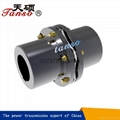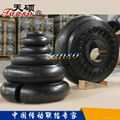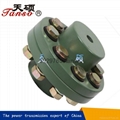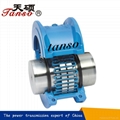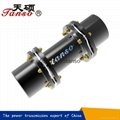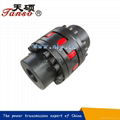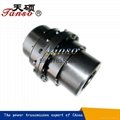| Model: | NL1 |
|---|---|
| Brand: | Tanso |
| Origin: | Made In China |
| Category: | Industrial Supplies / Machinery / Hydraulic Pressure Machine & Parts |
| Label: | gear coupling , nylon coupling |
| Price: |
US $13.5
/ pc
|
| Min. Order: | 1 pc |
Product Description

A gear coupling is a mechanical device for transmitting torque between two shafts that are not collinear. It consists of a flexible joint fixed to each shaft. The two joints are connected by a third shaft, called the spindle.
Each joint consists of a 1:1 gear ratio internal/external gear pair. The tooth flanks and outer diameter of the external gear are crowned to allow for angular displacement between the two gears. Mechanically, the gears are equivalent to rotating splines with modified profiles. They are called gears because of the relatively large size of the teeth.
Gear couplings and universal joints are used in similar applications. Gear couplings have higher torque densities than universal joints designed to fit a given space while universal joints induce lower vibrations. The limit on torque density in universal joints is due to the limited cross sections of the cross and yoke. The gear teeth in a gear coupling have high backlash to allow for angular misalignment. The excess backlash can contribute to vibration.
Gear couplings are generally limited to angular misalignments, i.e., the angle of the spindle relative to the axes of the connected shafts, of 4-5°. Universal joints are capable of higher misalignments.
Advantages of Tanso gear coupling
1. Lowest price based on large scale production.
2. High and stable quality level.
3. Widely used in various mechanical and hydraulic fields.
4. Compensation for axial, radial and angular misalignment.
5. Convenient axial pl ing assembly.
6. No brittlement at low temperature.
7. Good slippery and frictional properties.
8. Resistance to chemical corrosion.
9. Rich experience working with big companies in this field.
Design advantages

The Flexible Coupling method of connecting rotating shafts is a vital and necessary technique. Large massive shafting, loosely mounted in sleeve bearings and merely joined together by rigidly bolted flanges, cannot provide efficient mechanical power transmission. Especially today, as machine designers and builders demand higher speeds, higher torques, and higher misalignment capacities, the need for “flexibly connecting” this equipment becomes apparent.
A flexible coupling is necessary since it is practically impossible to achieve and maintain perfect alignment of coupled rotating shafts. During initial assembly and installation, precise alignment of the shaft axes is not only difficult to achieve but in many cases it is economically unfeasible. During operation, alignment is even more difficult to maintain. Shaft misalignment – caused by uneven bearing wear, flexure of structural members, settling of foundations, thermal expansion, shaft deflection and other factors – is an operating certainty. Because these factors are extremely difficult to control, a flexible coupling serves as an ideal answer to compensate or minimize the effects of unavoidable misalignment and end movement of coupled shafts.
A flexible coupling must provide three basic functions:
1. Physically couple together two rotating shafts for efficient transmission of mechanical power, transferring the torque of one shaft to the other, directly and with constant velocity.
2. Compensate for all types of misalignment between rotating, connected shafts without inducing abnormal stresses and loads on connected equipment, and without tangible loss of power.
3. Compensate for end or axial movement of the coupled shafts, preventing either shaft from exerting excessive thrust on the other and allowing each to rotate in its normal position.

Three types of misalignment must be effectively accommodated by a flexible coupling.
1. Parallel Offset – axes of connected shafts are parallel, but not in the same straight line.
2. Angular – axes of shafts intersect at center point of coupling, but not in the same straight line.
3. Combined Angular-Offset – axes of shafts do not intersect at point of coupling and are not parallel.

Product description

Nylon gear flexible coupling is the latest product,it has been using by abroad,and it is designed by mechanical committee of Jinan Casting forging machinery institute.
Features of NL gear coupling:
1.Absorb parallel,angular and axial misalignments
2.Simple assembly and disassembly
3.Easy maintenance and low noise
4.High tansmission efficiency
5.Long service life

|
Type |
Nominal torqueTn (N.M) |
Max speedn (r/min) |
Fundamental dimensions (mm) |
Max misalignment |
Moment of inertia(KgC m 2 ) |
Mass(Kg ) |
||||||||
|
Bore diameter
|
Bore length
|
L |
D |
D1 D2 |
E |
L3 |
Axial (mm) |
Parallel (mm) |
Angular α° |
|||||
|
NL1 |
40 |
6000 |
6 8 10 |
16 20 25 32 |
37 45 55 69 |
40 |
26 |
4 |
34 |
2 |
±0.3 |
1° |
0.25 |
0.85 |
|
12 14 |
||||||||||||||
|
NL2 |
100 |
6000 |
10 12 14 22 |
25 32 42 52 |
57 71 91 111 |
42 |
36 |
4 |
40 |
2 |
±0.4 |
1° |
0.92 |
1.7 |
|
16 18 20 24 |
||||||||||||||
|
NL3 |
160 |
6000 |
20 22 24 |
52 62 |
113 133 |
66 |
44 |
4 |
46 |
2 |
±0.4 |
1° |
3.10 |
2.6 |
|
25 28 |
||||||||||||||
|
NL4 |
250 |
6000 |
28 30 32 |
62 82 |
129 169 |
83 |
58 |
4 |
48 |
2 |
±0.4 |
1° |
8.69 |
3.6 |
|
35 38 |
||||||||||||||
|
NL5 |
315 |
5000 |
32 35 38 |
82 112 |
169 229 |
93 |
68 |
4 |
50 |
3 |
±0.4 |
2° |
14.28 |
5.5 |
|
40 42 |
||||||||||||||
|
NL6 |
400 |
5000 |
40 42 45 |
82 112 |
230 |
100 |
68 |
4 |
52 |
3 |
±0.4 |
2° |
18.34 |
6.8 |
|
48 |
||||||||||||||
|
NL7 |
630 |
3600 |
45 48 50 |
82 112 |
229 |
115 |
80 |
4 |
60 |
3 |
±0.6 |
2° |
56.5 |
9.8 |
|
55 |
||||||||||||||
|
NL8 |
1250 |
3600 |
48 50 55 |
112 142 |
229 289 |
140 |
96 |
4 |
72 |
3 |
±0.6 |
2° |
98.55 |
26.5 |
|
60 63 65 |
||||||||||||||
|
NL9 |
2000 |
2000 |
60 63 65 |
142 172 |
295 351 |
175 |
124 |
6 |
93 |
4 |
±0.7 |
2° |
370.5 |
37.6 |
|
70 71 75 80 |
||||||||||||||
|
NL10 |
3150 |
1800 |
70 71 75 80 |
142 172 212 |
292 352 432 |
220 |
157 |
8 |
110 |
4 |
±0.7 |
2° |
1156.8 |
55 |
| Payment Terms: | TT |
|---|---|
Member Information
| Cangzhou Tanso Coupling Go.,Ltd. | |
|---|---|
| Country/Region: | He Bei - China |
| Business Nature: | Manufacturer |
| Phone: | 8223937 |
| Contact: | Tiffany Tang (sales manager) |
| Last Online: | 16 Mar, 2017 |
Related Products of this Company
-
TAS disc coupling
US $95
-
WGT gear coupling
US $68
-
High quality DL2 tyre shaft couplings
US $40.62
-
FCL flexible pin & bush coupling
US $22
-
JS grid coupling
US $50
-
TAL disc coupling
US $150
-
DC gear coupling
US $110
-
SWC-BH cardan shaft/universal joint
US $100
-
TS-SF flexible jaw type coupling
US $25
-
GIICL gear coupling
US $66

